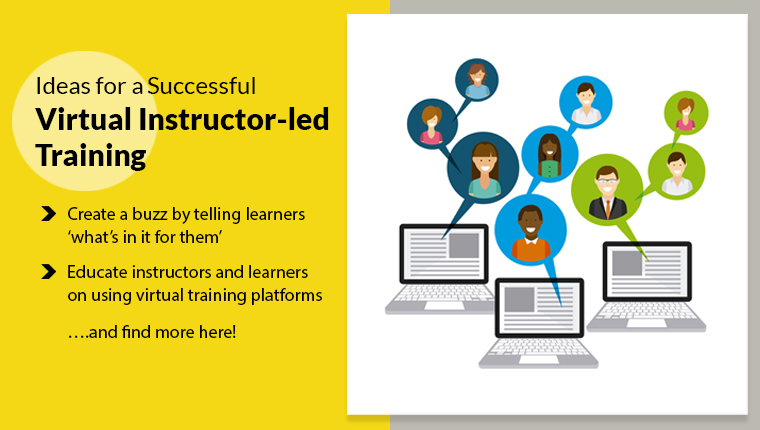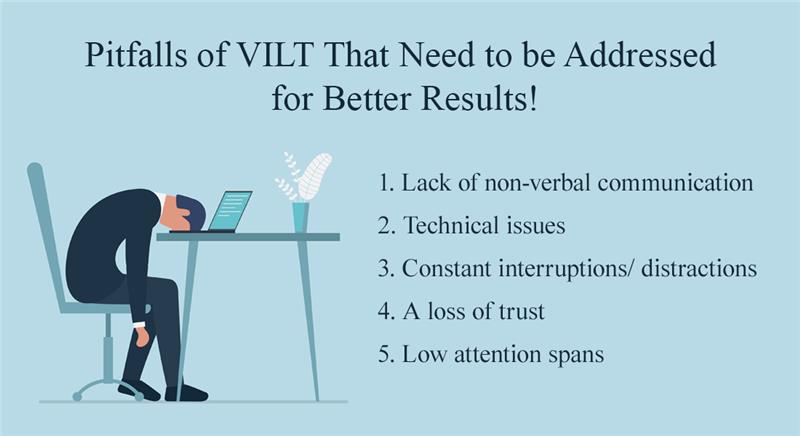A Tried & Tested Recipe for Successful Virtual Instructor-led Training

No one saw it coming! Nobody ever anticipated the scale at which the COVID-19 outbreak would affect our lives – both at work and at home. In the past few weeks, there has been a sudden spike in organizations’ interest in everything virtual, especially when it came to corporate training. According to Training Industry, there has been an 8,135% increase in interest on topics related to Virtual Instructor-led Training (VILT), remote working, and leading through adversity and change.
That’s not very surprising as most of the corporate workforce is working from home and organizations are looking for ways to meet their training needs effectively under these circumstances. Adopting a virtual instructor-led training strategy will certainly help you get your training back on track.
4 Ideas for Successful Virtual Instructor-led Training
- Create a buzz by telling learners ‘what’s in it for them’
- Educate instructors and learners on virtual learning platforms through ‘how-to’ guides
- Enhance engagement through collaborative activities
- Offer reinforcement through digital assets
I know what you’re thinking. “It’s all well and good about VILT. It hardly takes a genius to figure out that we need to adopt digital and online formats to manage work and training effectively during this lockdown. But the real question is – what can we do to get the most out of VILT sessions?”
Well, here are 4 ideas to make virtual instructor-led training a success.
How to Plan for Successful Virtual Classroom Sessions
1. Create a Buzz by Telling Learners ‘What’s in it for Me (them)”
When does a VILT session begin? The moment the instructor and learners log into their systems? Not really. After all, you can’t expect learners to attend a VILT session without providing them details as to why the session is scheduled or what the training is all about. So, before learners attend the actual training session, it is important to set expectations and inform them of the objective/s of the training.
Since you are dealing with adult learners, it is important to establish early why the training is relevant to them and how it can help them in their jobs. They need to know the ‘what’s in it for me’ to keep them interested and engaged in the training.
How can you do that? Well, you can use:
- Video trailers to attract learners to the training by giving them a sneak peek of what the training is all about and how will it help them become more skilled at their job roles.
- Pre-assessments to check learners’ prior knowledge and give them a chance to brush-up on the topics covered in previous training sessions. This will allow them to identify gaps in their knowledge and know which areas to focus on to fill those gaps.
2. Educate Instructors and Learners on Virtual Platforms through ‘How-to’ Guides
Going ahead with virtual learning requires both instructors and learners to have some degree of comfort in handling technology. I am not saying that they have to be an expert, but they should know how to access the different features offered by the software. A short ‘how-to’ guide on navigating the virtual learning platforms will come in handy for both instructors and learners.
The instructors will be able to make use of different features like screen-sharing, media sharing, and digital whiteboards to deliver training using different instructional strategies.
The learners will know how to access discussion boards and breakrooms to reach out to instructors and their peers and to access the resources and media files shared by instructors.
3. Enhance Engagement through Collaborative Activities
When you make the jump from classroom to virtual instructor-led training, you have to keep in mind that it is not going to be an easy ride. After all, there is something special about classroom training that remains unmatched by digital training formats – it is the physical presence and interaction between the instructor and learners.
But since physical proximity is going to do more harm than good in the present scenario (with all the social and spatial distancing to avoid getting infected by the virus), you can always replicate classroom interactivities in VILT sessions to enhance engagement.
How can you do that?
By making learners active participants in the training, of course! After all, nothing can boost engagement better than collaboration. And VILT allows multiple ways to do that.
- Role-playing will help learners understand how to act and behave during their job. For instance, a role-playing exercise with learners assuming the roles of sales reps and customers in different scenarios will help them improve their up-selling and cross-selling skills.
- Online polls during and between the training session will help keep learners on their toes and also allow instructors to assess the knowledge and understanding gained by learners.
- Digital whiteboards will allow instructors and learners to actively participate in the training process.
4. Offer Reinforcement through Digital Learning Assets
Can we say, “The training is done”, once learners and instructors sign off from the virtual learning platforms? No, not at all. Learning is not a one-off event; it is a continuous process. It is very important to reinforce training if you want your learners to retain what they have learned during the VILT session. This needs to be done for learners to perform their best at their jobs. And you can do that very easily.
- You can make the recording of the VILT session available for learners. You can also break them into different parts and deliver them as microlearning modules.
- You can take the most FAQs posted on discussion boards and make infographics based on the answers. These can work as job-aids providing performance support to learners.
Summing it Up!
I hope these ideas will help you plan for an interesting virtual instructor-led training. You have to remember that the key to any successful training plan is making the whole process ‘learner-centric’. Give learners a chance to steer their learning and it will surely boost their engagement and ensure they make the most of the VILT sessions.
To know more about how you can generate motivation and excitement in virtual instructor-led training, download our free eBook. It offers tips, tools, and solutions to combat the challenge of keeping your learners motivated and excited in the virtual classroom.






![A Beginner’s Guide to Virtual Instructor-led Training [eBook]](https://blog.commlabindia.com/hubfs/Imported_Blog_Media/virtual-instructor-led-training-beginners-guide-ebook.jpg)